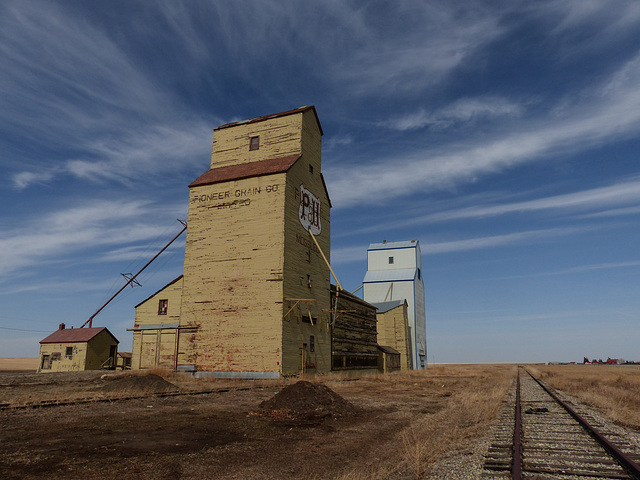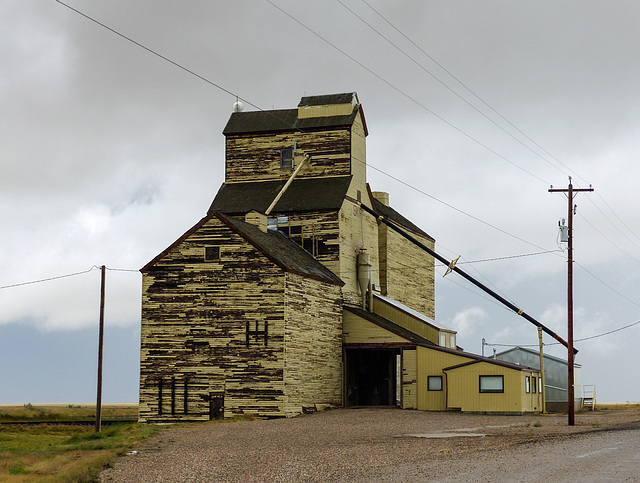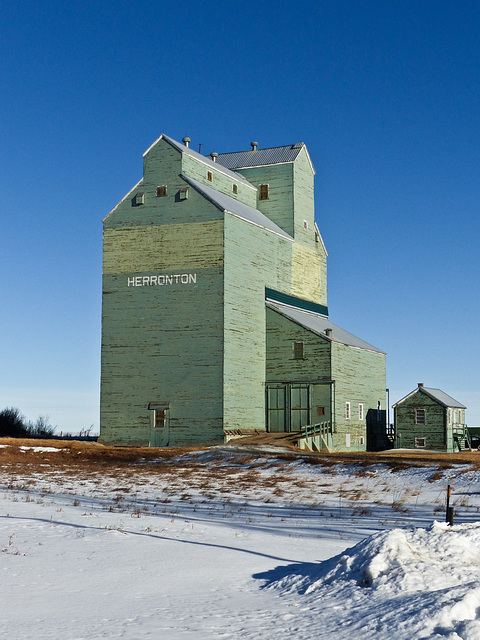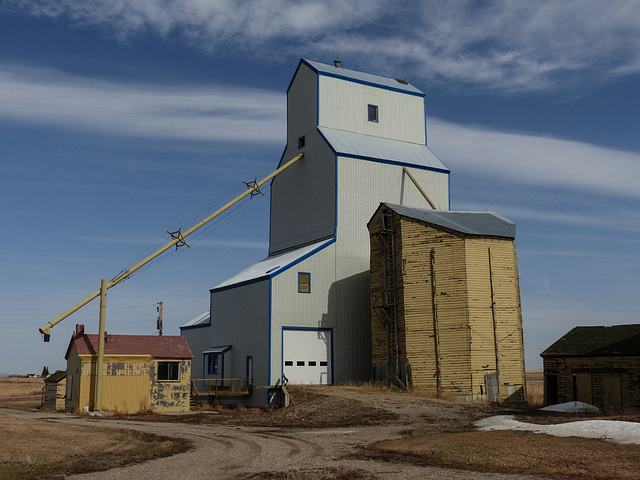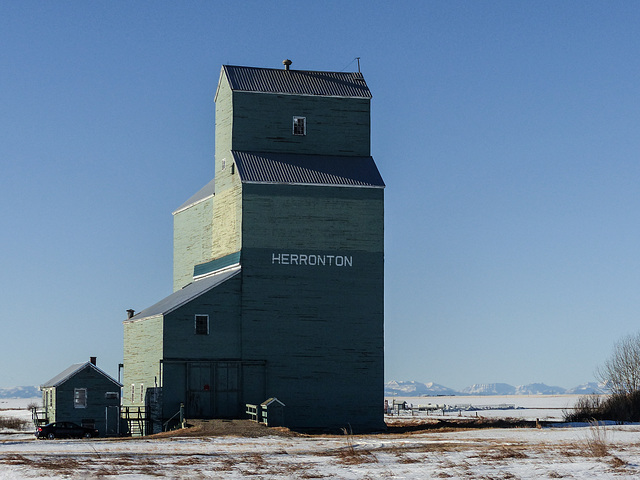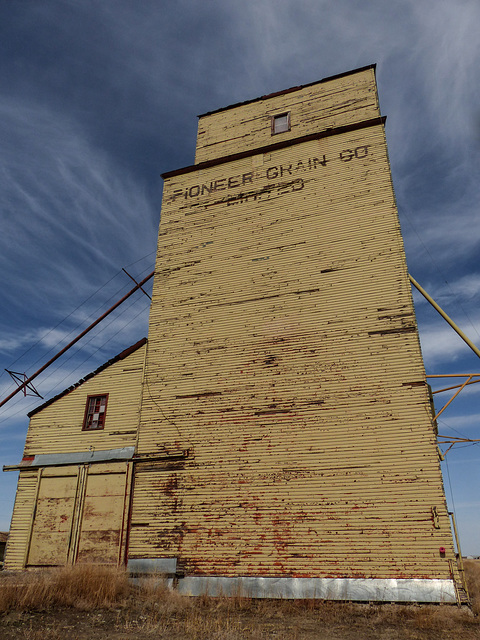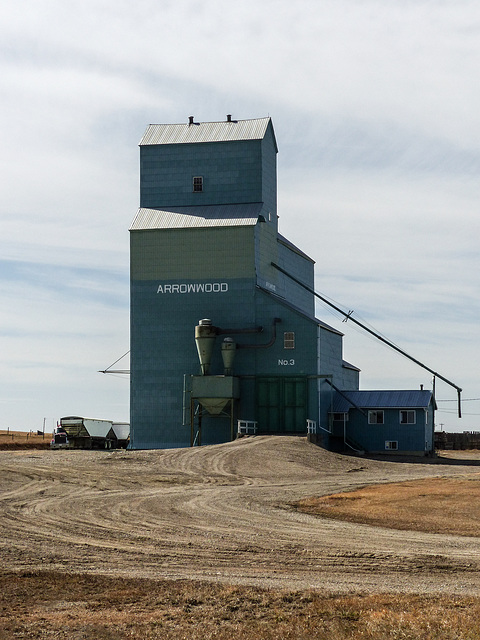
Grain elevators
29 Sep 2014
Badland sentinel
Four days ago, on 29 September 2014, I finally drove out to an area that lies NE of Calgary, that I had longed to go to for so many years. It must have been 30+ years ago that I first saw one particular area of the Badlands of Alberta. A few times since then, I had been fairly close when I went on several botany trips out that way, but when you are carpooling, you can't just go wherever you want. So, my youngest daughter and I decided that we both wanted to make this trip, All summer, we had been waiting for a day on which she didn't have to work and where the weather forecast was for no rain on the day or there had been no rain the previous day. The Bentonite Clay in the area becomes treacherously slippery when wet. The forecast for this day was for a mainly sunny day - at last, we were going!
I think this was the longest day of driving I had ever done, especially to, and in, an area that I'd never driven to before. For anyone who doesn't know me, I have battled a driving phobia for decades, plus I have barely any sense of direction, lol! Thankfully, my daughter has an amazing sense of direction, so I knew we wouldn't be stuck out on the prairies in the middle of nowhere. A typical question at too many intersections went as follows: me - "Do we go left?"; my daughter - "No, we go right", lol!
I met my daughter at 8:00 am. and I got home shortly before 9:00 pm. Much of that time was spent driving; the rest was spent wandering round three main areas - The Hoodoo Trail, Dorothy and Rowley, in different directions from Drumheller (known for its remarkable dinosaur findings). The forecast was far from accurate on our drive out to the Badlands and I began to wonder if we'd made a mistake going on this trip on that particular day. However, knowing that snow would be returning very soon ("returning" because we had two snowstorms on 9 and 10 September), I was beginning to feel rather desperate and really didn't want to risk not getting out there this year. The afternoon was less cloudy and we did have some sun.
So, the first of our destinations was The Hoodoo Trail, a small area of protected, spectacular hoodoos (rock formations), and then we went further, to the almost-ghost-town of Dorothy. I had longed, for such a long time, to see the two small, old churches that are to be found in Dorothy, as well as the old grain elevator seen in this photo. This photo was obviously taken before the sun eventually came out. This abandoned icon of the prairies stands at the edge of the main road and will probably end up crumbling or being destroyed before too long, like so many other grain elevators in Alberta. Such a waste, that they are not protected.
After that, we drove over 11 bridges and called in at the tiny hamlet of Wayne, passing the old Atlas Coal Mine. Much as we would have liked to visit the mine, we knew that we just didn't have time. Then we went to Rowley to see the old grain elevators and to wander round this very small, historical place. There are actually three elevators, with two being right next to each other and the other one a little further from them. Dorothy felt and looked almost deserted, whereas Rowley was beautifully kept.
From Rowley, we made our way back across the prairies to Calgary. I had planned on getting back before it got dark as I no longer like night driving and very rarely do it, but we didn't quite make it. On the return drive, the last sighting was a Great Horned Owl that was perched part way up a power pole. Well done, Rachel, spotting this welcome bird! Not easy to see in the dark. By the time I got home, I was so tired and my arms were so painful from driving, but, what a great day we had!!
"There were 1,651 elevators in Alberta in 1951, but by 1982 a total of 979 elevators remained. The 1990s spelled the death of the wooden “country” or “primary” elevator. At the end of the 1990s, as the full impact of both of the ending of the Crow Rate in 1995 and further impending rail abandonment was felt, the pace of demolition accelerated at an unprecedented rate. At the end of the 1996-1997 crop year, there were only 327 elevators left. Alberta’s largest cooperative grain companies, the Alberta Wheat Pool (which amalgamated with Manitoba Pool Elevators in 1998 as Agricore) and United Grain Growers, ultimately formed a new corporate entity known as Agricore United in 2001, issuing issued public shares. Demolition of country elevators has continued, and in 2005 there were only 156 wooden elevators of any kind still standing, only a handful of which are used by the grain trade.
The Government of Alberta has recognised the significance of the traditional wood grain elevators, and has designated 12 as Provincial Historic Resources. They are located in the following communities: Andrew, Castor, Leduc, Meeting Creek, Paradise Valley, Radway, Rowley (3 elevators), Scandia and St. Albert (2 elevators)."
www.grainelevatorsalberta.ca/articles/HRM-history.pdf
www.bigdoer.com/8049/exploring-history/prairie-sentinels-...
14 Apr 2014
2 favorites
Mossleigh grain elevators
These old, wooden grrain elevators are two out of the three that still stand at Mossleigh, SE of Calgary. The third is just off to the left of my photo. They were seen on 14 April 2014, when my youngest daughter and I spent the day driving some of the backroads SE of Calgary.
From Alberta Prime Time - Talk of the Town: Mossleigh Grain Elevator Trio. Original Air Date: Thursday, April 05, 2012:
"A farm family in the Mossleigh area of Southern Alberta is doing all it can to keep their local grain elevators towering over the prairies.
Eric Donovan and his cousin purchased two of the three aging structures when the original owner had no more use for them. Now they're being restored to working condition."
Link to an interesting article from Vulcanadvocate.com, from March 2012:
www.vulcanadvocate.com/2012/03/26/mossleigh-area-resident...
"There were 1,651 elevators in Alberta in 1951, but by 1982 a total of 979 elevators remained. The 1990s spelled the death of the wooden “country” or “primary” elevator. At the end of the 1990s, as the full impact of both of the ending of the Crow Rate in 1995 and further impending rail abandonment was felt, the pace of demolition accelerated at an unprecedented rate. At the end of the 1996-1997 crop year, there were only 327 elevators left. Alberta’s largest cooperative grain companies, the Alberta Wheat Pool (which amalgamated with Manitoba Pool Elevators in 1998 as Agricore) and United Grain Growers, ultimately formed a new corporate entity known as Agricore United in 2001, issuing issued public shares. Demolition of country elevators has continued, and in 2005 there were only 156 wooden elevators of any kind still standing, only a handful of which are used by the grain trade.
The Government of Alberta has recognised the significance of the traditional wood grain elevators, and has designated 12 as Provincial Historic Resources. They are located in the following communities: Andrew, Castor, Leduc, Meeting Creek, Paradise Valley, Radway, Rowley (3 elevators), Scandia and St. Albert (2 elevators)."
www.grainelevatorsalberta.ca/articles/HRM-history.pdf
28 Aug 2014
Skiff Elevator, after the storm
Skiff is a hamlet in southern Alberta. Before friends, Cathy and Terry, and I, set out on a three-day trip to Waterton Lakes National Park (26, 27 and 28 August 2014), I had discovered that we would be quite near to Skiff and its old grain elevator. I had mentioned this to my friends, asking if a quick stop to get a couple of shots might be possible if we had time. However, little did we know that we would end up having to stop in Skiff anyway, as Skiff was the closest place for us to get to after we got caught in a severe storm. We stopped at some kind of machinery warehouse to ask something and one of the workers said that he had never seen a storm like this one! A couple of minutes away, we found the beautiful, old elevator. You could still feel the tail end of the storm, with very strong winds blowing, barely letting me open my car door and walk with great difficulty to get my photos. I was surprised that my photos came out at all, I was being blown so much off balance.
The weather forecast that I saw before we left Calgary said that we were in for three beautiful days of sunshine. So, luck was on our side, giving us warm, sunny days - until the BIG STORM hit! We had driven eastwards from Waterton, hoping to see Yellow-bellied Marmots and, if we were really lucky, a Burrowing Owl. The storm was approaching very fast, around 5:00 p.m. just before we started our return trip to Calgary. It was like nothing I had ever seen before - a menacing cloud that was travelling fast and furious. I have recently posted a couple of photos of the storm. Despite trying our best to get away from it, it eventually engulfed our car, surrounding us with more or less zero visibility, pounding hail, thunder and lightning, and tremendously strong winds. There was nothing to do but sit tight in the car, hoping that the hail would not break the car windows and that this severe thunderstorm would not develop into a tornado! This storm was very scary, but at the same time, "exciting" (only because all turned out OK in the end!). Fortunately, we weren't caught in the very centre of it. Our road trip sure went out with a bang! Later, I contacted the Alberta Tornado Watch and posted a photo for them to see. They said the storm that happened that day was a mesocyclone.
This elevator is the sole remaining elevator in Skiff and, though now wearing Parrish & Heimbecker colours, may well have been an Alberta Wheat Pool elevator originally. If so, it was built in 1929 with a 40,000 bushel capacity. The annexes were added in 1948 (East) and in 1952 (West). The larger one is on the east side. The elevator appears to still be in use. There is very little information online about it, unfortunately.
www.waymarking.com/waymarks/WMKTFF_Alberta_Wheat_Pool_1_S...
15 Mar 2014
Grain elevator, Blackie, Alberta
When I was on a birding day trip with a group of friends, going SE of Calgary on Saturday, 15 March 2014, we called in at the small hamlet of Blackie. I had been there with other friends two days earlier and I had spotted a couple of very distant Eurasian Collared Doves in a tree. When I mentioned this on Saturday, the expectation (lol!) was that, despite my dreadful sense of direction, I would find the same tree again - amazingly, I did, and then my friends spotted about six of these birds in various trees. While we were walking along one of the streets, we saw this massive Cargill grain elevator. Not exactly the most beautiful of structures and definitely not as photogenic as the three old, wooden elevators that apparently used to be along the railway line, just a very short distance away, but still rather impressive. Luckily, a Canadian Pacific train came along while we were there - the wagons that you can see behind the engine on a different track at the far left of the image were already parked there.
In 2004, Blackie apparently had 3 elevators, an Ex-Agricore, Pioneer and Agricore United steel elevator. The large, green, wooden elevator was torn down in 2005 and replaced by this huge, modern grain loading terminal. The other wooden elevator, the Pioneer elevator, was torn down in December 2012. It was a fairly modern, seemingly well-kept elevator. Wish I had seen these, but I hadn't plucked up courage to drive SE of Calgary back then.
"There were 1,651 elevators in Alberta in 1951, but by 1982 a total of 979 elevators remained. The 1990s spelled the death of the wooden “country” or “primary” elevator. At the end of the 1990s, as the full impact of both of the ending of the Crow Rate in 1995 and further impending rail abandonment was felt, the pace of demolition accelerated at an unprecedented rate. At the end of the 1996-1997 crop year, there were only 327 elevators left. Alberta’s largest cooperative grain companies, the Alberta Wheat Pool (which amalgamated with Manitoba Pool Elevators in 1998 as Agricore) and United Grain Growers, ultimately formed a new corporate entity known as Agricore United in 2001, issuing issued public shares. Demolition of country elevators has continued, and in 2005 there were only 156 wooden elevators of any kind still standing, only a handful of which are used by the grain trade.
The Government of Alberta has recognised the significance of the traditional wood grain elevators, and has designated 12 as Provincial Historic Resources. They are located in the following communities: Andrew, Castor, Leduc, Meeting Creek, Paradise Valley, Radway, Rowley (3 elevators), Scandia and St. Albert (2 elevators)."
www.grainelevatorsalberta.ca/articles/HRM-history.pdf
www.bigdoer.com/2848/exploring-history/grain-elevators-an...
25 Jan 2014
2 favorites
1 comment
Herronton elevator
This is the second morning in the last three days that I've posted my "daily three" very late in the morning. After getting to bed each night around 3:00 a.m.or 3:30 a.m., I overslept till about 11:00 a.m. again today, which messes up my day. The reason for today's lateness is that I spent an amazing day out yesterday with friends Cathy and Terry, south of Calgary, and then got to bed so late after getting things done on my computer. I had found an e-mail on my computer around 12:45 a.m.yesterday, just as I was about to turn off my computer for the night. Did I want to go birding tomorrow (i.e. yesterday) and, if so, to meet at 8:00 a.m.. A full day of excitement and enjoyment left me tired out, but so happy. Can you believe that we saw 17 owls yesterday? SEVENTEEN! I didn't photograph quite every single one, but my friends will let me know exactly how many of each owl we found, once they've gone through their photos. It was something like 10 Snowy Owls and 7 Great Horned Owls. The closest Snowy Owl was seen when it was early evening and the light had gone, and my photos are all blurry. The other owls were little more than a tiny speck in the far, far distance, but I still managed to get some kind of shot of some of them, using 48x zoom plus cropping. We ended up driving through the hamlet of Herronton (SE of Calgary) late morning and stopped long enough to take a few shots of the old grain elevator there. Not fun walking even a few steps, as the recent melting snow has frozen over everywhere, including here in Calgary.
"There were 1,651 elevators in Alberta in 1951, but by 1982 a total of 979 elevators remained. The 1990s spelled the death of the wooden “country” or “primary” elevator. At the end of the 1990s, as the full impact of both of the ending of the Crow Rate in 1995 and further impending rail abandonment was felt, the pace of demolition accelerated at an unprecedented rate. At the end of the 1996-1997 crop year, there were only 327 elevators left. Alberta’s largest cooperative grain companies, the Alberta Wheat Pool (which amalgamated with Manitoba Pool Elevators in 1998 as Agricore) and United Grain Growers, ultimately formed a new corporate entity known as Agricore United in 2001, issuing issued public shares. Demolition of country elevators has continued, and in 2005 there were only 156 wooden elevators of any kind still standing, only a handful of which are used by the grain trade.
The Government of Alberta has recognised the significance of the traditional wood grain elevators, and has designated 12 as Provincial Historic Resources. They are located in the following communities: Andrew, Castor, Leduc, Meeting Creek, Paradise Valley, Radway, Rowley (3 elevators), Scandia and St. Albert (2 elevators)."
www.grainelevatorsalberta.ca/articles/HRM-history.pdf
"The Herronton elevator is a large former Alberta Wheat Pool elevator. The rail line here is not used. The last grain trains were loaded here a long, long time ago (late 1990s/early 2000s). This massive “single composite” elevator dates from 1965 having been rebuilt from an earlier structure (dating from 1930)."
www.bigdoer.com/2848/exploring-history/grain-elevators-an...
14 Apr 2014
1 favorite
Mossleigh grain elevator
On 14 April 2014, I spent a wonderful, fun day with my youngest daughter, driving the backroads SE of Calgary. Some of the roads were familiar to me, but others were new territory, which gave us a chance to discover some different abandoned barns and anything else that we thought was interesting and/or beautiful. We knew where our destination was going to be, more or less Mossleigh and Arrowwood, though it was disappointing that the "heat wave" distortion was just too great to get distant, zoomed photos of this row of old grain elevators. It was quite a hazy day, which never helps. Once we got really close, the problem thankfully lessened.
A very interesting and informative website, with a lot of information about this row of old elevators, is found at the following link. I find myself returning often to Chris and Connie's site to read about other places they have visited. It's well worth a visit to read about their travels.
www.bigdoer.com/2360/exploring-history/mossleigh-elevators/
According to the website at the above link:
" Update: May 2013. The lineage of the Mossleigh grain elevators has been cleared up. One was built for P&H, one for Pioneer which was later taken over by P&H, and finally one was built for the Searle Grain Company, later UGG and finally P&H. All were built in 1930 but it’s not clear exactly when they changed hands. A forth elevator used to sit here (UGG) but it was destroyed by fire in the 1960s.
Update: September 2013. It’s understood that plans are in place to use the track that remains along the subdivision for some sort of tourist train, operating out of the nearby Aspen Crossing campground/garden centre complex. Time will tell if this will come to fruition – Aspen Crossing as it turns out, does have some rail cars sitting on a section of subdivision track just west of Mossleigh."
WEATHER:
Tonight and all tomorrow - snow (5-10 cms)
Sunday & Monday - rain
Tuesday - isolated showers
Wednesday - cloudy with sunny breaks
Thursday - cloudy
Friday - rain
Wednesday looks like the only partly decent day - and I have to spend it indoors on my volunteer shift, lol!
25 Jan 2014
Herronton Elevator
On 25 January 2014, I spent an amazing day out with friends Cathy and Terry, going SE of Calgary. A full day of excitement and enjoyment left me tired out, but so happy. I had been missing being out and taking photos, feeling lethargic and extremely tired, so this invite was welcomed with open arms. The crazy weather soared to a balmy 11C, but a lot of the day was colder, with a strong wind! Can you believe that we saw 17 owls yesterday? SEVENTEEN! - 10 Snowy Owls and 7 Great Horned Owls. The closest Snowy Owl was seen when it was early evening and the light had gone, and my photos are all blurry. The other owls were little more than a tiny speck in the far, far distance, but I still managed to get some kind of shot of some of them, using 48x zoom plus cropping. We ended up driving through the hamlet of Herronton late morning and stopped long enough to take a few shots of the old grain elevator there. Not fun walking even a few steps, as the recent melting snow has frozen over everywhere, including here in Calgary.
"There were 1,651 elevators in Alberta in 1951, but by 1982 a total of 979 elevators remained. The 1990s spelled the death of the wooden “country” or “primary” elevator. At the end of the 1990s, as the full impact of both of the ending of the Crow Rate in 1995 and further impending rail abandonment was felt, the pace of demolition accelerated at an unprecedented rate. At the end of the 1996-1997 crop year, there were only 327 elevators left. Alberta’s largest cooperative grain companies, the Alberta Wheat Pool (which amalgamated with Manitoba Pool Elevators in 1998 as Agricore) and United Grain Growers, ultimately formed a new corporate entity known as Agricore United in 2001, issuing issued public shares. Demolition of country elevators has continued, and in 2005 there were only 156 wooden elevators of any kind still standing, only a handful of which are used by the grain trade.
The Government of Alberta has recognised the significance of the traditional wood grain elevators, and has designated 12 as Provincial Historic Resources. They are located in the following communities: Andrew, Castor, Leduc, Meeting Creek, Paradise Valley, Radway, Rowley (3 elevators), Scandia and St. Albert (2 elevators)."
www.grainelevatorsalberta.ca/articles/HRM-history.pdf
"The Herronton elevator is a large former Alberta Wheat Pool elevator. The rail line here is not used. The last grain trains were loaded here a long, long time ago (late 1990s/early 2000s). This massive “single composite” elevator dates from 1965 having been rebuilt from an earlier structure (dating from 1930)."
www.bigdoer.com/2848/exploring-history/grain-elevators-an...
14 Apr 2014
1 favorite
One of three grain elevators at Mossleigh
On 14 April 2014, I spent a wonderful, fun day with my youngest daughter, driving the backroads SE of Calgary. Some of the roads were familiar to me, but others were new territory, which gave us a chance to discover some different abandoned barns and anything else that we thought was interesting and/or beautiful. We knew where our destination was going to be, more or less Mossleigh and Arrowwood, though it was disappointing that the "heat wave" distortion was just too great to get distant, zoomed photos of this row of old grain elevators. It was quite a hazy day, which never helps. Once we got really close, the problem thankfully went away.
A very interesting and informative website, with a lot of information about this row of old elevators, is found at the following link. I find myself returning often to Chris and Connie's site to read about other places they have visited. It's well worth a visit to read about their travels.
www.bigdoer.com/2360/exploring-history/mossleigh-elevators/
According to the website at the above link:
" Update: May 2013. The lineage of the Mossleigh grain elevators has been cleared up. One was built for P&H, one for Pioneer which was later taken over by P&H, and finally one was built for the Searle Grain Company, later UGG and finally P&H. All were built in 1930 but it’s not clear exactly when they changed hands. A forth elevator used to sit here (UGG) but it was destroyed by fire in the 1960s.
Update: September 2013. It’s understood that plans are in place to use the track that remains along the subdivision for some sort of tourist train, operating out of the nearby Aspen Crossing campground/garden centre complex. Time will tell if this will come to fruition – Aspen Crossing as it turns out, does have some rail cars sitting on a section of subdivision track just west of Mossleigh."
Happy day! I've just found out that if you click on the row of three dots, then RIGHT click on Edit Date, you can open a photo in another tab or window and simply copy all the tags from there. When pasted in the tags of a new photo, they post perfectly. This was one of the things I really did not like about the new Flickr experience, until today, so that's one less thing to dislike.
14 Apr 2014
Arrowwood grain elevator
This old, wooden grain elevator was seen on 14 April 2014, when my youngest daughter and I spent the day driving some of the backroads SE of Calgary. There used to be a row of five elevators here, but now only one remains.
"There were 1,651 elevators in Alberta in 1951, but by 1982 a total of 979 elevators remained. The 1990s spelled the death of the wooden “country” or “primary” elevator. At the end of the 1990s, as the full impact of both of the ending of the Crow Rate in 1995 and further impending rail abandonment was felt, the pace of demolition accelerated at an unprecedented rate. At the end of the 1996-1997 crop year, there were only 327 elevators left. Alberta’s largest cooperative grain companies, the Alberta Wheat Pool (which amalgamated with Manitoba Pool Elevators in 1998 as Agricore) and United Grain Growers, ultimately formed a new corporate entity known as Agricore United in 2001, issuing issued public shares. Demolition of country elevators has continued, and in 2005 there were only 156 wooden elevators of any kind still standing, only a handful of which are used by the grain trade.
The Government of Alberta has recognised the significance of the traditional wood grain elevators, and has designated 12 as Provincial Historic Resources. They are located in the following communities: Andrew, Castor, Leduc, Meeting Creek, Paradise Valley, Radway, Rowley (3 elevators), Scandia and St. Albert (2 elevators)."
www.grainelevatorsalberta.ca/articles/HRM-history.pdf
www.bigdoer.com/8049/exploring-history/prairie-sentinels-...
Jump to top
RSS feed- Latest items - Subscribe to the latest items added to this album
- ipernity © 2007-2024
- Help & Contact
|
Club news
|
About ipernity
|
History |
ipernity Club & Prices |
Guide of good conduct
Donate | Group guidelines | Privacy policy | Terms of use | Statutes | In memoria -
Facebook
Twitter



